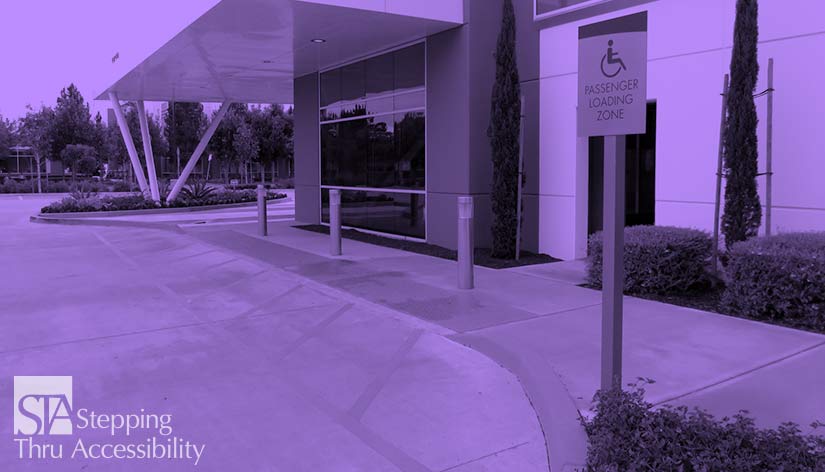Blog
Return to Blog »
Janis Kent, FAIA Architect, CASp © February 2019. Updated February, 2020 Recently, it has come to my attention that there is some confusion on passenger loading zones and what are the actual requirements. It is also difficult to determine if the requirements are misunderstood based on drawing review, since on-grade markings appear to be shown. It is just that they are incorrectly placed in the pull-up space. Basically, there are three components for a passenger loading zone. One is the vehicle pull-up space. The second is the drop-off loading area. And the third, is the pedestrian connection to the rest of the site. These spaces are not required to be signed nor is the accessible space reserved with an ISA for those with a placard or special license plate. The vehicle pull-up space is like it sounds – it is where the vehicle pulls up and stops. It is a minimum of 20’ long that is 8’ minimum in depth with a 2.083% maximum slope in all directions. Wherever you have pull-up spaces, one minimum is required to be accessible. And if there is more than one pull-up space, you will need to provide an accessible space for every 100 linear feet or portion of. These spaces do not need to be demarcated. If they are located along a vehicular route, they should probably be inset so as not to block traffic. The accessible pull-up space has a drop-off loading area similar to an access aisle. This area is for passengers/pedestrians and really should be protected to prevent vehicles from encroaching which can be done by insetting the loading area with a curb or bollards at each end. The area is the full length of the 20’ minimum pull-up space by 5’ minimum deep, fully contiguous, and on the same level as the pull-up space, also with a maximum slope of 2.083% in all direction. It is this loading area that should be painted or marked to prevent vehicles from encroaching. California requires a painted border with hatched lines 36” maximum on center. The color is not stipulated other than that it contrasts with the paving. And like an access aisle, nothing should be located within the space. The accessible drop-off loading area needs to connect to an accessible route. If there is a curb then a curb cut ramp needs to be provided and California requires a 36” deep strip of detectable warnings on the ramp surface. If the drop-off loading area has a blended transition to a sidewalk or walkway, California also requires a 36” deep strip of detectable warnings for the full length. Both the detectable warnings and curb ramp can not be located within the drop-off loading area, but rather beyond it since no height changes are allowed. The pull-up space with an accessible drop-off loading area is required where you have valet parking. It is also required at mechanical access parking garages both at the vehicle drop-off and the vehicle pick-up areas. Licensed medical care and long-term care facilities, where the stay may be over 24 hours, have a requirement for a minimum of one accessible pull-up space at the accessible entry which would also require a drop-off loading area. Another item to note, is that the pull-up space, its drop-off loading area, and the full vehicular route to and from it have a minimum height clearance of 114”. So be aware if you have valet drop-off within a parking garage that has limited height clearance or even if trees over-hang the vehicular route, that they provide the minimum height clearance. Also, be aware that this requirement is for passenger vehicles, not buses, which have different requirements for access. Be aware that your local City or County may have additional requirements that are more restrictive than the State or Federal requirements. Also, this article is an interpretation and opinion of the writer. It is meant as a summary – current original regulations should always be reviewed when making any decisions. Janis Kent, FAIA Architect, CASp © February 2019Valet & Passenger Loading Zones – What do I Need to Provide?

Pull-Up Space
Drop-Off Loading Area
Pedestrian Connection